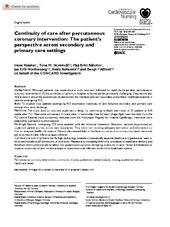| dc.contributor.author | Valaker, Irene | en_US |
| dc.contributor.author | Norekvål, Tone M. | en_US |
| dc.contributor.author | Råholm, Maj-Britt | en_US |
| dc.contributor.author | Nordrehaug, Jan Erik | en_US |
| dc.contributor.author | Rotevatn, Svein | en_US |
| dc.contributor.author | Fridlund, Bengt Gotthard Anton | en_US |
| dc.date.accessioned | 2017-12-21T11:16:38Z | |
| dc.date.available | 2017-12-21T11:16:38Z | |
| dc.date.issued | 2017 | |
| dc.Published | Valaker I, Norekvål TM, Råholm M, Nordrehaug JE, Rotevatn S, Fridlund BGA. Continuity of care after percutaneous coronary intervention: The patient's perspective across secondary and primary care settings. European Journal of Cardiovascular Nursing. 2017;16(5):444-452 | eng |
| dc.identifier.issn | 1474-5151 | |
| dc.identifier.issn | 1873-1953 | |
| dc.identifier.uri | https://hdl.handle.net/1956/17070 | |
| dc.description.abstract | Background: Although patients may experience a quick recovery followed by rapid discharge after percutaneous coronary interventions (PCIs), continuity of care from hospital to home can be particularly challenging. Despite this fact, little is known about the experiences of care across the interface between secondary and primary healthcare systems in patients undergoing PCI. Aim: To explore how patients undergoing PCI experience continuity of care between secondary and primary care settings after early discharge. Methods: The study used an inductive exploratory design by performing in-depth interviews of 22 patients at 6–8 weeks after PCI. Nine were women and 13 were men; 13 were older than 67 years of age. Eight lived remotely from the PCI centre. Patients were purposively recruited from the Norwegian Registry for Invasive Cardiology. Interviews were analysed by qualitative content analysis. Findings: Patients undergoing PCI were satisfied with the technical treatment. However, patients experienced an unplanned patient journey across care boundaries. They were not receiving adequate instruction and information on how to integrate health information. Patients also needed help to facilitate connections to community-based resources and to schedule clear follow-up appointments. Conclusions and implications: As high-technology treatment dramatically expands, healthcare organisations need to be concerned about all dimensions of continuity. Patients are witnessing their own processes of healthcare delivery and therefore their voices should be taken into greater account when discussing continuity of care. Nurse-led initiatives to improve continuity of care involve a range of interventions at different levels of the healthcare system. | en_US |
| dc.language.iso | eng | eng |
| dc.publisher | Sage | eng |
| dc.rights | Attribution CC BY-NC | eng |
| dc.rights.uri | http://creativecommons.org/licenses/by-nc/4.0/ | eng |
| dc.subject | Percutaneous coronary intervention | eng |
| dc.subject | continuity of care | eng |
| dc.subject | qualitative content analysis | eng |
| dc.subject | nursing | eng |
| dc.subject | qualitative method | eng |
| dc.subject | healthcare levels | eng |
| dc.title | Continuity of care after percutaneous coronary intervention: The patient's perspective across secondary and primary care settings | en_US |
| dc.type | Peer reviewed | |
| dc.type | Journal article | |
| dc.date.updated | 2017-12-15T07:56:36Z | |
| dc.description.version | publishedVersion | en_US |
| dc.rights.holder | Copyright The European Society of Cardiology 2017 | |
| dc.identifier.doi | https://doi.org/10.1177/1474515117690298 | |
| dc.identifier.cristin | 1442904 | |
| dc.source.journal | European Journal of Cardiovascular Nursing | |

